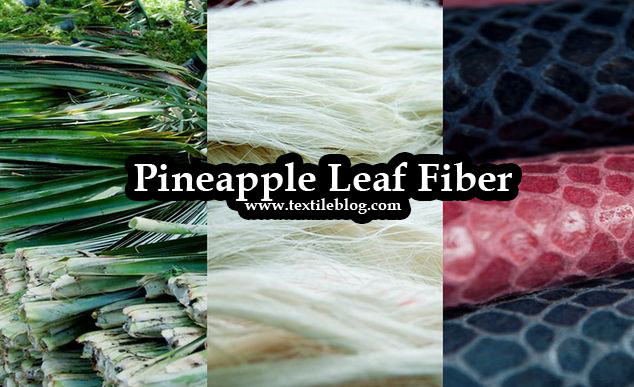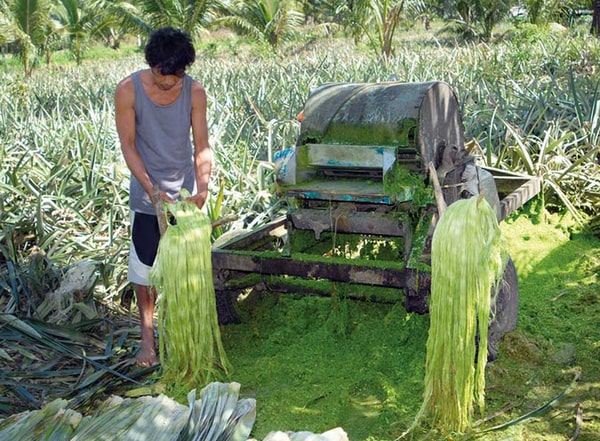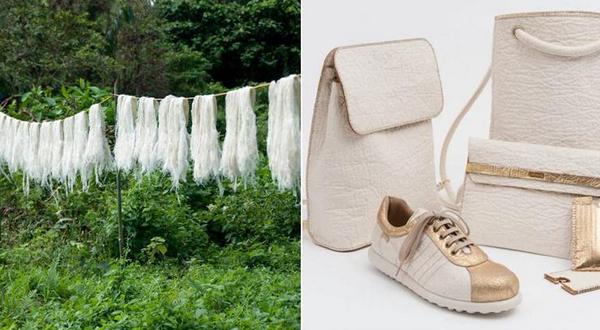Pineapple Leaf Fiber:
Pineapple is one of the most important commercially grown fiber crops since it yields fruit and textile fiber both. Pineapple is a common tropical plant, which belongs to the family of Bromelia. While most Bromeliads grow on trees, the pineapple is a ground fruit. This plant is native to the southern part of Brazil and Paraguay. The quality of the pineapple which is used for extraction of fiber is different from what is grown as a fruit. The leaves of a fruit bearing plant also yield fiber; however, they do not yield good quality fiber. Pineapple plants, with long leaves, specially cultivated for its fiber give the finest quality of pineapple leaf fiber.
Now a days plant fibers are widely using for numerous applications from many resources. The most important property of pineapple fiber is biodegradability and noncarcinogenic which bring it back into fashion, with an advantage of being cost-effective. Pineapple leaf fiber is more delicate in texture than any other vegetable fibers. It helps in climate restoration and soil quality by preventing soil erosion. It is white, creamy and lustrous as silk fiber and is 10 times as coarse as cotton, although it is fine (as fine quality jute) with well separated filaments. The fiber can easily retain dyes. The bundle strength of the pineapple leaf fiber diminishes on wetting; however the strength of the yarn increases. A mature plant has about 40 leaves, with each leaf being 1-3 inches broad and ranging in length from 2-5 feet. The average plants per hectare are around 53,000 plants, which can yield 96 tonnes of fresh leaves. On an average one tone of fresh leaves can yield 25 kg of fibers, thus total fiber extraction can be around 2 tonnes of fiber per hectare.

Every year a significant mass of pineapple fibers are being produced, though very small portions are being used in the field of feedstock, energy production and cloth making. In recent times, the manufacturing waste from pineapple leaves is used in sustainable materials like biocomposites. The worldwide area under pineapple harvest in the year 2017 was 1,098,705 hectare (ha) which can supply approximately 1318 thousand ton of PALF which consider 40 ton/ha usable fresh leaves and 3% PALF yield. Freshly harvested green leaf bundles are used for fiber extraction. Fiber length is dependent on leaf length of the cultivator. Caribbean region’s long leaves of pineapples are considered the most suitable for fiber extraction.
Pineapple plants are largely grown in tropical America, Far-East Asian countries and Africa. In year 1960s and 1970s, Malaysia was one of the top players in the pineapple industry among three main pineapple producing countries after the Philippines and Costa Rica. However, in years afterward, Malaysia was not included as the main producer anymore and has been replaced by other countries. Brazil and Thailand was the largest producers of pineapple fibers in the world in 2008. Brazil accounted for around 13%, while Thailand and Philippines accounted for around 12% of global pineapple production during 2008. But at 2019, the top ten pineapple producers supplying approximately 70.5% pineapple yield around the world have been entitling towards Colombia, Mexico, China, Nigeria, India, Indonesia, Thailand, Philippines, Brazil and Costa Rica. Looking at the top ten countries producing pineapple, Costa Rica takes the first position showcasing production capabilities of 68.15 ton/hectare of fruits and 300 ton of pineapple leaf stubbles/ha. In Philippines and Taiwan, the pineapple plant is largely used as a source of fiber. In India and Bangladesh, also the pineapple plant is used as a source of fiber. Cloth made from pineapple leaf fiber in Philippines is exported to various parts of the world, most particularly to North America and Europe.
Extraction Process of Pineapple Leaf Fiber:
The process of fiber extraction from the pineapple leaf can be done either manually or with the aid of machines. The manual process involves stripping off the fiber from the retted leaf. Fibers of the leaf are scrapped by means of a broken plate or coconut shell and a fast scraper can extract fiber from over 500 leaves per day after which the fibers are washed and dried in the open air. In this method a lot of fiber is lost and the entire process is also very laborious. With this process, the yield is around 2-3% of dry fiber, which is about 20-27 kg of dry fiber from 1 tone of pineapple leaf. The manual process of extracting fiber is very laborious, time consuming and also there tends to be a lot of wastage. After drying, the fibers are waxed to remove the entanglements and the fibers are knotted. During the knotting process, each fiber is extracted singly from the bunch and knotted end to end to form a long continuous strand. The fiber is then sent for warping and weaving.

In the mechanical process, the green leaf is cursed in a raspador machine. The soft green parts of the leaves are crushed and washed in water and the thread is taken out. The thread is then brushed with a comb and fine threads are separated from the spongy ones.
The last step is knotting of the threads by hand and spinning the threads with the help of a charka. This final product is one thread, which can be used for preparation of fabric and clothes. The longer threads are used for making fabric, while the smaller ones can be use for making carpets, sponge seats and ropes.
Properties of Pineapple Leaf Fiber:
Pineapple Fiber is softer, and has a high luster, and is usually white or ivory in color. Piña fiber has its own creates a sheer, stiff material that is light in weight, perfect for use in sub-tropical climates for traditional formal wear & accessories.

Some of the characteristics of the pineapple fiber are:
- It is very hygroscopic.
- Coloured white with a sleek appearance.
- It has high cellulose content.
- Shiny as silk.
- It has a low microfibrillar angle.
- Moderate in length.
- Fiber bundle strength decrease by 50% when wet.
- Yarn strength increase by about 50% when wet.
- Difficulties in dye penetration due to high coarseness.
- Sweat absorbent and breathable fiber.
- Hard and not wrinkling properties.
- Good antibacterial and deodorization performances.
End uses of pineapple fiber:
Handicraft artisans in Philippines have been using pineapple leaves for long to produce cloth. Pineapple silk is considered the queen of Philippine fabrics and is considered the fabric of choice of the Philippine elite. Pineapple fiber is sometimes combined with silk or polyester to create a textile fabric, which is lightweight, has an elegant appearance similar to linen and easy to care. The pineapple threads have also been used for long in India and China for lines and threads and as an adulterant in silk. Pineapple leaf fiber is also used for table linens, bags, mats and other clothing items, where lightweight and stiff fabric is needed. The characteristics of the fabric made from pineapple fiber make it ideal for high grade suits, shirts, divided skirt, decorative fabrics and so on.

Pineapple leaf fiber finds different uses across the various parts of the world. The Chinese weave the fiber into coarse textiles, which resembles grass cloth. In India, the thread is used by shoemakers. In West Africa, the thread is used in the jewellery sector for stringing jewels and also for making caps worn by tribal chiefs. The people of Guam make fine casting nets by hand-twisting the fiber; also use it for wrapping or sewing cigars. Pineapple fiber is used for making cloth and is also at times combined with silk or polyester to create textile fabric. There is extensive potential for pineapple fabric, given its diverse uses and eco-friendly properties. Besides, pineapple leaf fiber (PALF) can be a new source of raw material to the industries and can be potential replacement of the expensive and nonrenewable synthetic fiber. At present, pineapple leaf fiber is enormously popular among the composite research community due to its various advantages including its smoothed and scaled morphology, low thickness, firmness, reduced weight and superior mechanical properties. Specially, pineapple leaf fibre is completely/partially biodegradable and recyclable, cheap to produce and easy to make.
References:
- Pineapple Leaf Fibers: Processing, Properties and Applications by Mohammad Jawaid, Mohammad Asim, Paridah Md. Tahir, Mohammed Nasir
- Natural Fibers by Dr. Abu Bakr Siddique & Dr. Hosne Ara Begum
- M. Asim,Khalina Abdan, M. Jawaid, M. Nasir, Zahra Dashtizadeh, M. R. Ishak, and M. Enamul Hoque “A Review on Pineapple Leaves Fibre and Its Composites” vol. 2015, no. 16, doi: 10.1155/950567
- https://textilelearner.net/application-of-pineapple-leaf-fibre-in-automotive-industry/
